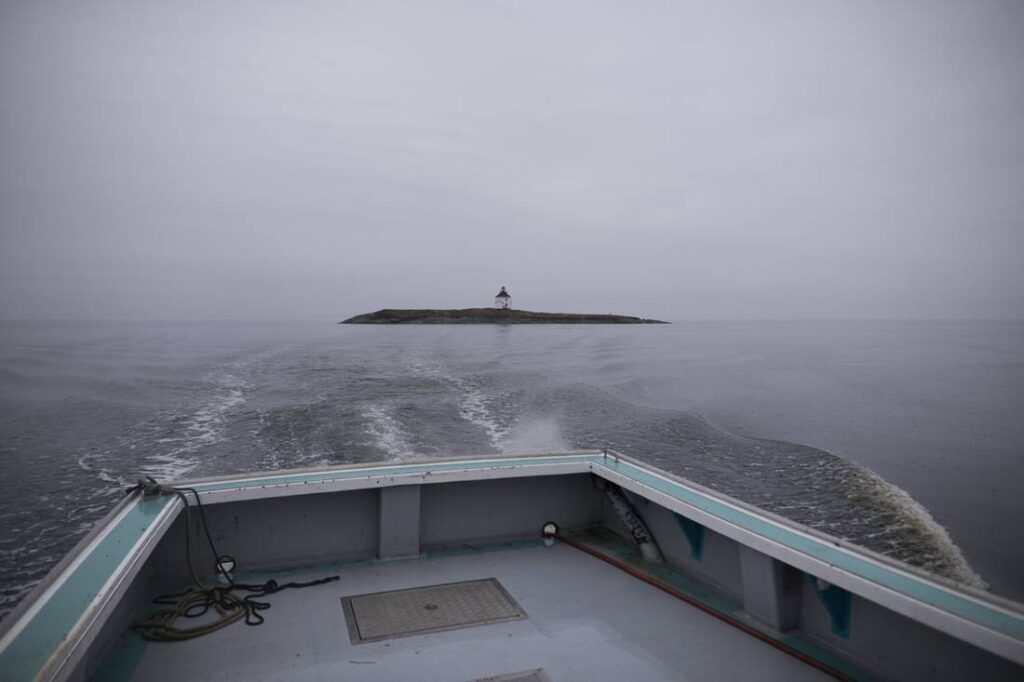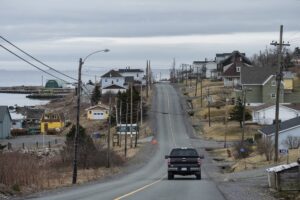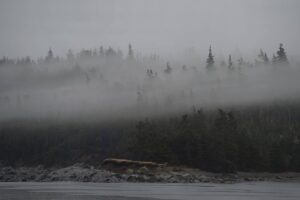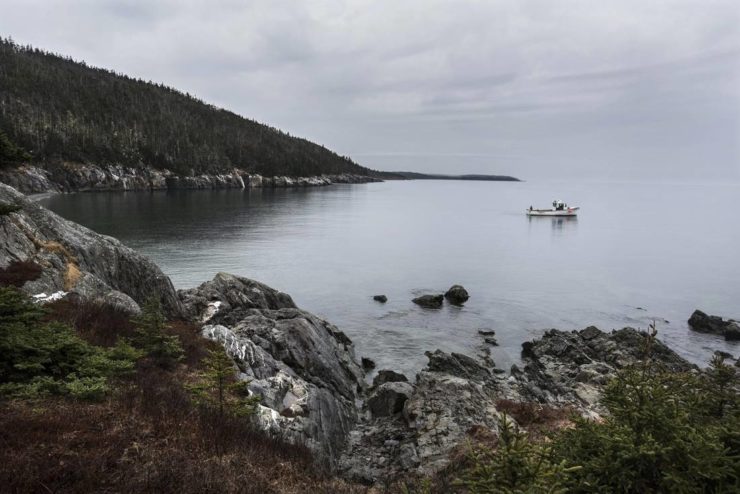The word “lament” is a sadly beautiful thing, its layers and meanings distinct, yet entwined. In music, it is a song of loss, of missing someone or something that is no longer there. As a verb, it expresses grief, or regret. In both verb and song form, it has a keening feel to it.
I kept thinking of the word as I read “The Ballad of Fogarty's Cove,” a story by Canadian writer Josh O’Kane about a cove made famous in a Nova Scotian folk song that has become a metaphor for the battle between jobs and preservation – of land, but also of memories.
All the layers of the word come together in the piece: the regret over leaving the land of your birth because you cannot make a living there; the sorrow over the loss of a childhood place of exploration and beauty; and, at its heart, the song itself, by a Canadian folk singer, Stan Rogers, who died too young.
Realizing a narrative structure over the course of months brings more of a simmering self-satisfaction, like you’ve learned a secret you get to use for the rest of your life.
I’ve been having a bit of a Nova Scotia moment recently. I’m totally smitten with “Island,” the collected short stories of the wonderful Cape Breton writer Alistair MacLeod, whose themes of hardship and love and loss seem to thrum throughout O’Kane’s piece.
And I recently read “Far Out Isn’t Far Enough: Life in the Back of Beyond,” the memoir of illustrator Tomi Ungerer, who moved from New York City to a Nova Scotian farm in the 1970s. (It’s not your typical starry-eyed story of a city type escaping to the country, not least because of the beautiful illustrations; I highly recommend it.)
And now I’m in Nova Scotia for the annual International Association for Literary Journalism Studies conference. I can’t wait for it to begin.
It seemed like a perfect time to chat with O’Kane, a business writer for The Globe and Mail in Toronto, and spotlight some lovely writing about the Maritimes.
The conversation, conducted via email, has been edited for flow.

First of all, do you come from Nova Scotia? You seem very in tune with the place and its people. Do you feel the pull of the place while you’re away?
I’m from New Brunswick, just next door. Growing up on Canada’s east coast, you try to ascribe unique characteristics to each city or province, but since I moved to Toronto, I’ve come to understand the Maritime provinces more regionally, having fought against similar political climates and economic hardships for centuries.
For a long time, my closest circle of friends in Toronto were all Maritimers. We collectively realized that the pull of home is universal, and often talked about it, though less so now that we’ve made new friends and settled into careers here. Until I got a full-time gig at the Globe, my parents regularly asked if I’d consider coming back to try opening a digital news outlet.
Some friends did move back east. Those of us determined to stay found other ways to pay tribute, from journalism to tattoos to buying property out there. I haven’t bought property out there.
Can you talk a bit about storytelling as part of the culture of Nova Scotia, especially through its music? You cite this lyric by Rogers, which gives me chills: “We Finches have been in this part of the world for near 200 years/but I guess it’s seen the last of us.”
I think about the themes of exile and leaving in Maritime song pretty well constantly. The Fogarty’s Cove story is a spiritual spinoff of my first book, “Nowhere With You.” It’s about the music of Halifax songwriter Joel Plaskett through the lens of leaving Canada’s east coast – he stayed, but emerged from a 1990s alternative scene that saw bands constantly split up or split town. Leaving creeps up constantly in his music; given my weird guilt about having moved away, I thought it was worthy of study.
The book devotes most of a chapter to Atlantic Canada’s long, winding relationship with leaving home, especially through song. In the region’s original music, it’s shown up for at least a century and a half: from traditional folk like “Farewell to Nova Scotia,”to the country of Hank Snow, to the light pop of Anne Murray, to the new-generation-trad of Stan Rogers. While some writers douse their songs in metaphor, Stan wrote songs about what he literally saw in Canso, Nova Scotia – “Fogarty’s Cove” being one of the most prominent examples. He stuck with me.

This piece seems like an archetypical Nova Scotia story: It has the bonds to place; it has the push-pull of stunning natural beauty and a desperate lack of jobs; it has folk music, which seems part of their DNA, like setting their life stories to music. Is that what drew you to it?
I didn’t even know Fogarty’s Cove was an actual place, at first. While in Halifax to research the book, Stan Rogers was already on my mind, and a friend mentioned he’d heard it was real, and that it had been expropriated for a quarry. The local newspaper had done a story about it, but it was more of an “angry locals with their arms crossed” angle. I wondered if there was a bigger-picture piece there, zooming out at the broader contexts. The Globe loves stories about regional economies and cultural history; the quarry proposal at Fogarty’s Cove felt like an allegory for the Maritimes’ longstanding tension between both. Plus, I’m officially a business reporter at The Globe, and happen to love writing about music, which is not a common skill set. Being a Maritimer on top of that, knowing what it was like to live there, it felt like this story was… meant for me?
But I also had a book deadline to meet and rock stars to interview. It was 14 months later, after sending the final edits to my publisher, when I pitched it to the Globe’s arts editor – because I was headed to Halifax for a wedding anyway. The editor bit, and convinced my usual manager to give me a week to spend in Guysborough County digging around. I missed the wedding rehearsal driving back from my hike to the quarry site – sorry again, Danielle and Chris – but I came back with so much good material that I was fired up about journalism for weeks.
As the central characters, Stan and the cove have something in common: Both are absent for tragic reasons. So I tried to write the story in a way that lets them haunt the narrative, like ghosts.
And was it daunting to try to write that kind of story, pulling in threads of history and lore with a current-day conflict?
At first, I thought this could be a tight 900-word piece, but after meeting the Fogarty brothers and spending hours scouring their documents, I realized I was terribly wrong. The cove’s story was their story, their ancestors’ story, Stan’s story, Stan’s family’s story, Canso’s story, Guysborough’s story, the environment’s story, and a quarry company from Alabama’s story.
I got some latitude, first for about 4,000 words, anticipating a month-away publishing date. I wrote 5,000 and it felt incomplete. I wound up with much better context and detail so that I could tell the story in ways that felt more linear for the reader.
Talk about how you decided to structure the piece. You have two central characters: the folk singer, Stan Rogers, and the cove itself. Then you have the current-day conflict over the cove. Was it difficult finding the arc of the story?
I had the rare benefit, at least as a newspaper reporter, of writing in chunks/subsections. But also as a newspaper reporter, I was first inclined to reveal the exact tension of the quarry high up.
The earliest draft took too long to get to Stan because I rushed the Fogarty brothers’ struggle to the top. My very excellent editor – Jared Bland, who’s now publisher of McClelland & Stewart at Penguin Random House Canada – suggested I push it down, and a more natural arc emerged. The final version might be the lowest I’ve ever dropped a “news hook” in a story.
As the central characters, Stan and the cove have something in common: Both are absent for tragic reasons. So I tried to write the story in a way that lets them haunt the narrative, like ghosts. Each of the first few chunks introduce a character or place, then alternatingly reveal a sense of Stan’s importance to history or a tension with the cove: Stan the child; struggling Canso; Stan the adult; jobs-focused Guysborough municipality; and finally the Fogarty brothers, and how everything that came before coalesced into their losing a chunk of family history.
The Fogarty brothers are almost an avatar for the cove itself – possessed by its ghost, so to speak. They let the second-half narrative speed forward more naturally: How are they fighting the quarry, and is that even feasible? Help piles up: environmentalist groups, a big-city investor, a legal loophole, and even Guysborough’s own data. I knew I needed to close with June Jarvis. She’s the reason Stan and Fogarty’s Cove matter – Stan’s avatar.
I like that the narrative isn’t black and white, but gray. There’s a “villain” in the quarry company, but that villain also offers jobs for a region that needs them. How hard was it to balance that?
The first characters I met were the Fogarty brothers, whose passion in getting their family land back was infectious. Hours later, when I checked into my bed-and-breakfast in Guysborough, the host asked what brought me there – it was well past tourist season – and I explained the story, mentioning the tension between jobs and history. “Well, we already know what should win,” she told me. “The jobs.” Everyone’s stake is emotional.
As I report in the story, Guysborough has put a selective spin on its public opinion claims, and a few characters voice the very real perspective that maybe a nature-shredding megaproject isn’t the most effective way to bring home jobs and people. But that hunger for jobs there, and across the Maritimes, is real. It can be easy to get caught up in the emotion of losing family history, but the struggle to find work has an emotional toll, too. Stan captured the balance of these emotions in his work. He was a fine role model.

What role did photography play in the storytelling?
I got to work with Darren Calabrese, a Halifax photographer who’d shot another weekend Arts cover story I’d written, and who does an incredible job conveying mood. We first wondered if we’d depict the cove with aerial photography, but he wound up traveling to Fogarty’s Cove by boat – I had gotten as close as I could via land – and his photos worked like a companion journey to the cove and back. The overcast shots of the cove captured the tone of the story so well; his photos of Canso show exactly what the village has been through; and his portraits do a great job establishing character.
You mentioned to me that this is the longest you’ve been able to spend on a story. How long did it take to report and write? And what do you think is the most valuable/rewarding aspect of being able to take more time than the fast-paced news cycle usually allows? I wouldn’t mind if you broke the last question into two parts: the reporting and the writing.
I pitched it in September 2015, visited Guysborough and Canso in October, and first planned to file by the start of November. That sounds rich, looking back. It was published in April, seven months after first picking up the phone.
Writing in October, I didn’t let myself worry about who hadn’t contacted me back, since I had so much material already. But once I slowed down, as I gradually rearranged the structure in between my daily stories, I made more phone calls. Characters like Garnet Rogers, Ariel Rogers, Glynn Williams and Steven Rhude came forward; Garnet alone helped me reframe the introduction around Stan, as opposed to quarry workers. I discovered more details in documents from Guysborough and environmental watchdogs. I even tracked down a petition from the early 2000s and tallied how many names were within a few dozen miles of Canso. Through all this, I was able to add detail and harden arguments, which made the writing come more naturally.
Taking as long as I did to report and write offered different kinds of excitement. Landing an unexpected interview or document is a fist-pumping kind of thrill, which you don’t always get if you jump on a new story every day or week. But realizing a narrative structure over the course of months brings more of a simmering self-satisfaction, like you’ve learned a secret you get to use for the rest of your life. Still, they fed into each other: by having more time to write, I was able to track down more information. By doing that reporting, I had a better story to write, and it became more complete and engaging.



